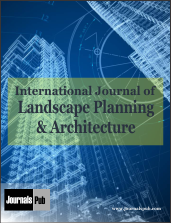Editor Overview
IJLPA maintains an Editorial Board of practicing researchers from around the world, to ensure manuscripts are handled by editors who are experts in the field of study.
Publisher
JournalsPubAn Imprint of Dhruv Infosystems Pvt Ltd
A-118, 1st Floor, Sector-63, Noida, U.P. India,Pin-201301
E-mail: [email protected]
(Tel):
(Mob) (+91) 9810078958, +919667725932
Focus and Scope

About the Journal
International Journal of Landscape Planning and Architecture [2456-5091(e)] is a peer-reviewed hybrid open-access journal launched in 2015 that provides a platform that publishes high-quality conference proceedings, original research articles, and editorial reviews from the field of landscape planning, ecosystem analysis, field ecology, and other major related issues.
Focus and Scope
-
Landscape archaeology of architecture: Archaeogeography, prehistorical, classic, and historic archaeologists, 3D modeling, post processualism, archeological theory, phenome logy, historic landscape characterization, landscape changes, cultural landscape, landscape studies, construction of knowledge, nature conservation, traditional practice.
-
The sustainable architecture of landscape: Development space, and the ecosystem, built environment, energy, and environmental conservation, human design, public spaces, urban culture behavior, collective memory, construction, landscape design, architecture design strategies, contemporary architecture.
-
Landscape gardening of Architecture: Designing and building landscapes, landscape design, Climate change, ornamental plants, floriculture, greenhouse gases, interior landscape, Vertical gardening, informal gardening, Wild gardening, garden and forest, ornamental plants, conservation, utilization of gardening.
-
Landscape engineering of Architecture: Mathematics and science, land and waterscapes, green engineering, landscape architects, applied sciences, anthropogenic landscapes, landscape contractors, earthwork calculations, and watersheds, stormwater management, landform cultivation, design and planning of landscape transportation plan, structural landscape design, site planning, ecological planning, environmental design.
-
Landscape design of Architecture: Artistic tradition, landscape designers, nature and culture, modern practice, landscape architecture, and garden design, ecological landscape design, sustainable city design and management, landscape design and maintenance, Cities are dynamic, Human, and natural processes.
-
Landscape management of Architecture: Urban regeneration, plasticity, urban planning, management and planning, heritage concept of landscape, creative industries zone, gray water, sprinkler system, landscape plants, landscape nursery, home garden landscape.
-
Landscape analysis of architecture: Potential collaborators, conducting market research, identifying competitors, regional geography, urbanization, landscape evolution, human interaction group, social interaction, natural environment, urban outdoor environment, demography, social landscape.
-
The evolutionary landscape of architecture: Biological entity, natural selection, genetic drift, gene, protein, population, or species, nucleotide sequences, fractal dimension, naturalness, rural landscape, peri-urban landscape, farmland grassland, habitat selection, habitat preference, aesthetic evolution, structural landscape modeling.
-
Landscape ecology of architecture: Environment and specific ecosystems, landscape scales, spatial patterns of development, and organization, landscape research, and policy, landscape diversity, the synergy of biodiversity and geodiversity, ecology and conservation, landscape surroundings, sustainability conservation, conservation, and human land.
-
Landscape pattern of architecture: Conservation practice and ecology, complex spatial pattern, spatial heterogeneity, linear networks, spatial attributes, landscape structure gradients, climatic, geological, ecological, and cultural, landscape human planning, spatial resolution, urban gradient analysis, landscape metrics.
-
Industrial landscapes of architecture: Industrial activity in industrialized and under-industrialized countries, underdeveloped, industrialized, wealthy countries, industrial community, multifunctionality, regeneration, local distinctiveness, multi-criteria analysis, post-industrial regeneration, regeneration delivery environment.
-
Regional landscapes of architecture: Reflected in regional landscapes, region’s architectural structures, statues, and monuments of local, national, or global significance, local habitat diversity, favor diversity of wildlife, regional diversity, ecosystem integrity, land use data and information, ecological communities, wetlands, geographic information system, gap analysis, habitat fragmentation.
-
Landscape indicators of architecture: Morphological, environmental, and cultural characteristics set of indicators, selection and implementation, local policies to protect landscape quality, landscape regulating function, microclimate control, landscape indexes, landscape indices, evolution in social land use.
-
Landscape diversity of architecture: Landscape elements, landscape structure, and function, patch types, patch size, and patch shape, landscape mosaic, spatial arrangement, species distribution, movements and diversity, wildlife planning, nutrient cycling, wildlife habitat protection, biodiversity conservation.
-
Landscape research of architecture: Academic backgrounds, researched and debated numerous times, scientific landscape, natural and human science, regional development, urbanizing world, translational landscape, landscape sustainability, integrative landscape, landscape perception.
Open Access Statement
IJLPA is an open-access (OA) publication which provides immediate open access to its content on the principle that making research freely available to the public supports a greater global exchange of knowledge. All published works will be available to a worldwide audience, free, immediately upon publication. Publication in the journal is subject to payment of an article processing charge (APC). The APC serves to support the journal and ensures that articles are freely accessible online in perpetuity under a Creative Commons licenses.
Publication Ethics Statement
IJLPA fully adhere to Code of Conduct of Publication Ethics (COPE) and to its Best Practice Guidelines. The Editorial Team enforces a rigorous peer-review process with strict ethical policies and standards to ensure the addition of high-quality scientific studies to the field of scholarly publication. In cases where ctit becomes aware of ethical issues, it is committed to investigating and taking necessary actions to maintain the integrity of the literature and ensure the safety of research participants. Click here to read more about the Research & Publication virtue ethics
Content Disclaimer
All IJLPA the information’s, opinions, and views mentioned here represents the authors and the contributions of the articles. Publication of articles, advertisements, or product information does not constitute endorsement or approval by the journal. cannot be help responsible for any error or consequences while using the information updated in this journal. Although every effort is done by ctit to see that there’s no any inaccurate data, misleading data, opinion or statement within the journal, the data and opinions appearing in the articles are the responsibility of the contributors concerned.



